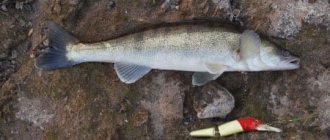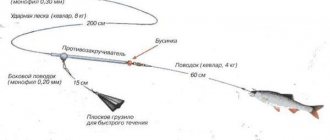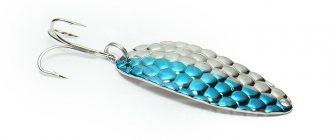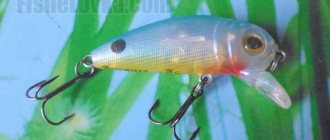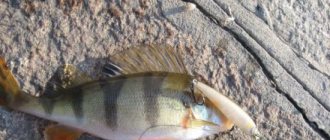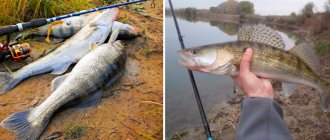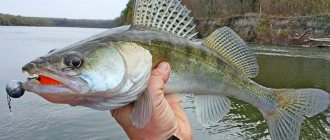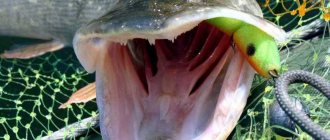Jig fishing for pike deserves special attention among the methods of hunting for predators due to its prey ability and simple technique for performing fishing techniques. An important factor in the popularization of jig was the variety of inexpensive, but at the same time effective baits used in this fishing method. Spinning for jig fishing for pike is a mandatory attribute of every fishing store, and as you know, availability generates interest and development, which influences the continued successful spread of jig in the fishing culture of predator fishing. Our next article will be about the secrets of jig fishing for pike.
Rules for choosing the right jig head
Fishing for pike on a jig is not complete without the use of weights, which are sinkers specialized for the fishing method, called jig heads. Heads are available in several variations of their shapes, each of which satisfies one or another hunting conditions. The most familiar to spinning players are stationary jig heads in the form of a lead ball with a hook soldered into the body, which are considered universal in jigs. But in addition to the ball, for better maneuverability of the bait, the shape of a boot can be used. In addition to stationary jig heads, manufacturers produce articulated weights or cheburashkas, which hinder the movement of rigs less and make the bait more mobile and more natural when retrieved. Hinged weights are also produced in the form of a bullet. These loads increase the range of the tackle.
Specifics of catching pike with jig in autumn
A feature of autumn pike fishing is its higher predictability. If throughout the year the toothy predator is dispersed throughout the reservoir, and it is not so easy to find it, then in the autumn period everything changes radically - any unevenness of the bottom is suitable. Moreover, a lot depends on what month the fishing takes place.
In September, it is most promising to look for pike on spits, near coastal vegetation, and on the near edges.
Video: jig at the end of September for pike
In October, the spotted predator slightly moves to the middle edges and still sometimes comes out to the near edges.
Video: catching pike with a jig in autumn in October from the shore
In November, the pike slides even deeper - into the deepest parts of the reservoir. Therefore, first of all, you need to fish the depths and their surroundings. However, exits of the predator into smaller places are also possible. Pike on jig in late autumn and even early winter before freeze-up can most likely be caught in the bays and sides of large rivers. And the catches during this period can also be impressive.
Video: catching pike with a jig in late autumn in November
Installation of equipment for catching pike with a jig
Preparation for catching predators with a jig begins with assembling and completing the equipment. The equipment is not complicated and includes standard elements selected for the weight of the baits used.
Important! It is worth paying attention to the choice of lightweight equipment, since jig fishing is one of the most dynamic methods of spinning fishing, and heavy tackle will not allow the angler to conduct even a couple of hours of high-quality and intensive casting fishing.
The kit itself consists of a spinning rod, a spinning reel, a cord and a bait combined with a jig head. We’ll talk more specifically about the parameters of each component in the continuation of our material.
Selecting a spinning rod, reel, hook and line
For jigging, semi-fast spinning rods are selected in lengths for coastal fishing from 2.3-2.7 meters and fishing from boats from 1.7 to 2.1 meters. Test parameters in pike fishing vary from 4 to 20 grams, which corresponds to the parameters of light and, occasionally, ultralight rods. The inertia-free mechanism must be distinguished by the reliability of the mechanism, because the main load of guiding and landing fish falls on this element of the equipment. Jig reels fit into the size selection parameters of 1500–3000 units, with a gear ratio of 1/5. You also need a friction clutch that allows you to adjust different loads from the resistance.
Important! For jig fishing, purely braided cords are used, which have a low stretch coefficient, which better transmits signals when animating the bait and biting the trophy.
Hooks are used based on the size of the bait. As a rule, these are hooks with an elongated shank. The fastening of the hook soldered into the head is located on the load. The hook used in hinged joints must have a fastening ring. The articulated jig head is mounted to the hook through just such a fastening ring. For non-hooking lures, offset hooks are used.
Important! A mandatory element of equipment when fishing for pike is a leash, which can be made of fluorocarbon line, steel or Kevlar.
The length of the leash varies from 15 to 30 cm, depending on the expected size of the trophy in the catch.
Pike fishing in November
In autumn, namely November, fishing for this predator may not always please the angler with a delightful catch, but this does not make it uninteresting. This is explained by the fact that the fishing process itself is quite exciting: selecting bait, choosing a location, taking into account weather conditions, choosing the most suitable fishing method, observing the predator. This is all really interesting and worth the effort!
Wiring method
There are really a lot of variations in fishing for pike. Many fishermen prefer to use stepped wiring. This is wiring with jerks at depth. When retrieving, the bait sinks to the bottom, and then, by pulling the fishing line, we lift the bait from the bottom. This is not difficult to do; usually 2-3 turns of the coil are enough. In order to prevent snags on the bottom during this wiring, it is preferable to use non-snagging hooks or an offset hook. The offset hook is also actively used for silicone baits.
Smooth, slow retrieve is also common among fishermen. To a greater extent, it is used when fishing with a spinner or spoon. The fishing line gradually tightens without any jerking, thereby attracting a predator.
It is also important to pay attention to the thickness of the fishing line and the integrity of the gear. Very often, fishermen use the so-called braided cord; it has a high breaking load, which makes it possible to use cords with a small cross-section. Braided lines are especially effective when fishing for pike with a spinning rod on the river.
Features of pike fishing in November
The pike bite in November has its own characteristics.
Very often, a pike swallows bait in the following way: it tries to swallow it right away, and then pauses a little and tries to turn it head first and begins to swallow. That is why it is necessary to strike precisely when the predator has completely swallowed the bait. So appropriate patience should be exercised. As noted earlier, in November, pike most often take from the depths, from the bottom. How does a bite feel? It feels like a thump and then a slight tug is felt. At first, it may even seem that the bait just got stuck in snags or got caught on algae. Of course, we should not forget that the pike very actively resists when fishing, so excessive slack should not be given.
It is important to be able to catch a predator in a timely manner and be able to prevent it from hiding in reeds or snags; the fact is that in this case you may not only be left without a catch, but also without your favorite spoon, wobbler, etc.
Jig head size and weight
Methods for selecting the required bait weight depend on the fishing conditions and, in particular, the strength of the current and the depth of the reservoir. For fishing currents with the same bait, heavier loads are used than for fishing with the same bait in still waters. This is due to movement errors during wiring, which occur as a result of the resistance of the bait to the flow. Jig fishing is mostly carried out in the bottom layers of a reservoir, and for fishing in deep areas, the weight of jig heads is increased to speed up the delivery of equipment to the bottom of the reservoir. So, if you fish at a depth of three meters, then it is effective to use a mass of 8 grams, and if you fish with the same bait at 10 meters, then it is reasonable to increase the mass to 14–15 grams. In this case, the time of the bait falling to three-meter and ten-meter depths will be almost identical in time.
Selecting a spinning rod
Any wiring is most effectively done with a powerful, sensitive and long spinning rod. With this method, you have to cast the bait over long distances, but at the same time, the rod should allow you to feel all its movements, touching the bottom and playing, and fishing can take place both in the current and in still water.
The power and strength of the spinning rod should ensure the transfer of the fish’s grip and a clear hook over a long distance. And there is no need to talk about prolonged fishing from afar, from great depths.
Therefore, a spinning rod for jig should be made of high-quality material, and its length should be 2.7-3.5 meters. It should have a two-handed handle to ensure long casting distance.
It should be taken into account that the weight range of thrown devices ranges from five to forty grams. The entire structure must have increased sensitivity.
Jig lures for pike
Classic jig baits for pike are, of course, made of silicone, although foam rubber baits and rotating spoons are also suitable for these purposes. It is impossible to unambiguously name the best bait option, because the preferences of the toothy bait are changeable, and the wiring technique of each spinning player, despite the common principles, differs in the nuances of execution. Therefore, only practice of wiring with development of their technique and experimentation in the use of different types of attachments can bring the expected result.
Silicone baits
Silicone baits come in a variety of shapes and colors. For pike fishing, the optimal sizes are considered to be silicone sizes starting from 80 mm. Smaller items also attract interest from fish, but the caught specimens will not differ in their significant size. Both inert and soft playing silicone are suitable for jigging.
Important! The use of edible rubber increases the number of bites.
In fishing, vibrating tails and twisters are preferable, although all kinds of slugs should also not be excluded from fishing strategies, especially if the bite is not stable and requires non-standard moves when fishing.
Foam rubber baits
Foam rubber is one of the cheapest types of bait. When the predator is highly active, the inertia of the bait does not particularly affect the result, but frequent losses in the writhing of more expensive rubber can upset the spinner, which is not the case with foam rubber, which you can cut yourself and paint with markers in promising colors from waste construction materials. For pike, shapes starting from 10 cm and thicknesses of 20–25 mm are suitable.
Spinners
Rotating spoons on wire frames with front loading are also successfully used in jig fishing. For pike jigs, select products with oblong petals, the working angle of which is within 45 degrees. Jig baits for large pike of this type are taken in numbers 3–5 according to the Meps classification. The only drawback of fishing with this tool is the depth, which should not exceed three meters.
How to catch pike with a jig
You can catch pike with a jig in various reservoirs; the only inconveniences to fishing are dense aquatic vegetation and silty bottom sediments, which do not allow the equipment to work properly. As a rule, jigs are used to fish hard bottom bases at the boundaries of aquatic vegetation, edges and dumps at the transitions to different depth levels, driftwood and dead wood. Promising points are considered to be places near hydrological structures and bridges, as well as stuck areas of water areas. The depth factor has little effect on fishing possibilities, which are equally successful both at meter and 10 meter marks.
Postings
During the cultivation of this type of fishing, jig wiring has acquired a number of distinct directions, which are considered basic in jig technology. Based on these techniques, spinning anglers, adding certain technical techniques to them, such as pauses, jerk length and bait toss height, practice their own jigging technique. We will present to the reader fundamental methods of posting that will help to understand the principles of jig fishing.
American way
The wiring technique is based on the animation of the bait using a fishing rod. After casting, the jig head is allowed to sink to the bottom and two or three pulls of 15–20 cm each are made with the spinning rod, and during a subsequent pause, reeling out the slack line. Thus, the equipment is carried out along the selected trajectory, selecting the length of the pauses and the magnitude of the pulls depending on the bites.
Step view
This method is based on animation of the bait with a reel. After the rig touches the bottom, the reel is made two or three full turns, alternating such winding of the cord with a pause. During the pause, the bait, raised from the bottom and making a step at each turn of the reel handle, falls to the bottom again. As in the previous case, by increasing the pause time, the optimal wiring rhythm is selected.
Aggressive wiring method
This technique is used in the complete absence of bites, when you need to force the predator to pay attention to the installation by sharply moving the equipment. The wiring style is similar to twitching. The bait is torn from the bottom with a sharp jerk of the rod; this is achieved by lifting the quiver tip of the tackle upward, throwing it 20–30 cm in the water column. After a pause, the spinning rod is returned to a horizontal position, while simultaneously reeling out the slack cord. The jig bait for pike acts with sharpness of movement and is attacked during a pause, after the first couple of jerks.
Carrying out demolition equipment
The demolition technique is carried out according to the principle of the American method of fishing, only fishing is carried out on the current. During the pause between pulls, the bait lifted from the bottom by the force of the current is carried along its course, and the excess cord is wound onto the spool of the reel. During demolitions, such silicones as twisters and worms perform well, the natural movement of which due to the forces of the current does not go unnoticed by the toothy one.
Uniform type of wiring
The most technically complex type of fishing, requiring the angler to strictly control the bait in the water column. Various water horizons are fished using this method. After casting, the bait is not placed on the bottom, but having reached a certain level, they begin a uniform reeling, during which a pause is made, moving the bait to a lower level, and when reeling begins, returning to the initial horizon. Thus, the installation makes wave-like movements in the water column. Otherwise, this technique is called pelagic jig.
Features of fishing at different times of the year
The jig fishing method undoubtedly differs depending on the season of the year. These changes affect both the behavior of the predator and the processes in changing the structure of the reservoir itself. For example, pike are more willing to jig in the fall than in the summer due to their increased feeding activity, and even in the autumn months, dormant aquatic vegetation opens up new points for comfortable fishing. We will discuss the nuances of spinning hunting in different seasons of the year in continuation of the jig theme.
Spring
They begin jigging already with the first melting of the ice cover, fishing for exits to the shallows in the coastal zones of the reservoir and riffles at the places where smaller tributaries with fresh water flow into rivers and lakes. In muddy waters, light-colored baits are used, making monotonous and non-aggressive retrieves. Peak fishing occurs during the pre-spawning period in March or April, which depends on the geographic location of the region. According to the observations of anglers in the spring, the bite is better in the afternoon, towards evening, although the fish become active in the morning, with full sunrise.
Summer
Summer is not the most productive time for jigging. The pike disperses throughout the reservoir, taking up positions in thickened areas of water areas where jig fishing becomes impossible. In the summer months, fishing is promising at the boundaries of clear water and thickets, in snags, as well as on river beds along the edges of holes and on rifts. Lures are used in medium sizes, using natural colors. Pike bite better in the early morning and evening hours, resting throughout the rest of the day.
Pike jigging in autumn
Catching pike with a jig in the fall is the most promising. The predator is noticeably more active, and water bodies are freed from algae and become more suitable for fishing than ever before. Since the beginning of the autumn season, they have been fishing in relatively shallow waters, moving with cold weather closer to the deeper parts of the water areas. The speed of the posting increases, as does their aggressiveness, and the largest silicone and foam fish are used as bait in the hope of catching large specimens. Jig hunting is carried out right up to freeze-up, throughout the daylight hours.
Techniques for catching pike with jigs in autumn
The simplest jig wiring is known to every novice spinning fisherman. Two or three turns of the coil and a pause. You can experiment with wiring by changing the number of turns and the length of the pause. long pauses and slow single turns in wiring with a passive toothed predator .
After the bait is cast, you should let it lie on the bottom . Sometimes this technique brings positive results.
Pike fatten up before winter throughout the entire autumn period, so in most cases standard jig wiring and its modifications are sufficient. In addition to standard jig wires, the spinning player’s assortment also includes a certain number of auxiliary wires :
- zigzag;
- pendulum;
- for demolition;
- dragging along the bottom.
A separate type of jig can be called vertical lure . With this method of fishing, the spinning angler floats on a boat and hits the bottom of the reservoir with a jig bait. In this case, a short fishing rod with a round Nevskaya-type reel is used.
Video: technique and tactics of autumn pike fishing with jigs


